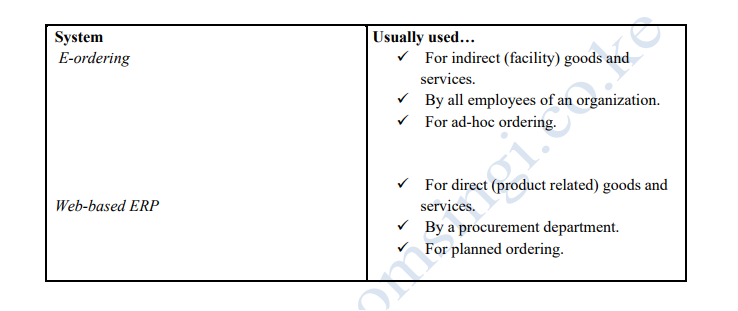The term eProcurement refers to the use of electronic means in conducting a public procurement procedure for the purchase of goods, works or services. In order to have a common view within the eProcurement Forum, for the scope of this initiative
the following sub-phases of the electronic public procurement process have been identified:
E-informing/ E-Noticing
E-informing is not directly associated with a stage in the procurement process; it is the process of gathering and distributing procurement information both from and to internal and external parties using Internet technology.
E-requisition
E-Purchase Requisition System is a complete web based system for managing, tracking and controlling purchase requisition process in your organization.
Key Benefits:
- Reduce the paper trail. Instead of filling out tons of paper forms, everything in the system is done electronically and kept electronically. Users simply submit an electronic requisition and check the status online.
- Everything is online. Reviewing piles of paper requisitions is a troublesome task, with e-Purchase Requisition System; managers can review electronic requisitions online that provide far more information and take less time to review. Any reviews or comments can be communicated with the requestor via e-mail.
- Easy approval setup. Administrator can setup the approval matrix easily using the administrative panel. Approval matrix can be set according to organization’s policy.
- Easy integration with various ERP systems- e-Purchase Requisition System is designed to have a quick and easy integration with various ERP systems. It interfaces with the various modules (Finance, Inventory or Purchasing) to provide creation of PR’s
and various analysis reports. - Reporting make easy- e-Purchase Requisition System features a variety of comprehensive reports for managers to do analysis and budgeting control.
- Security and privacy- e-Purchase Requisition employs extensive security measures to ensure your data is secure, and accessible only by authorized users within your organization. Access is controlled via a unique user name and password which users
must enter each time they log on to the system.
E-Purchase Requisition System extremely simple to use, data is automatically defaulted in for you wherever possible, and the description that you enter on-line for your goods/services is exactly what you request for. In addition, your order gets out to the vendor much quicker. It allows organizations to leverage the expense control benefits of traditional purchasing procedures without incurring the associated financial overhead or administrative burden. It helps to eliminate tons of paper forms as everything is done electronically.
Organizations simply set up their procurement processes and procedures in e-Purchase Requisition System, and the entire purchasing process is handled online. In additional, e-Purchase Requisition System can be integrated with various ERP systems such as
Microsoft Dynamics AX. It interfaces with the Inventory Module to provide creation of PR’s from the Low-level Inventory Report. It also interfaces with the Purchase Order Module. Creation of PO’s from PR’s and maintenance of inventory levels is automatic.
E-Purchase Requisition System consists of various sections for easy to use and maintain:-
- Purchase Requisition
- Requisition Review
- Approval Cycle
- Purchase Order
- Reporting
E-Ordering
E-ordering and web-based ERP is the process of creating and approving procurement requisitions, placing purchase orders, as well as receiving goods and services ordered, by using software systems based on the Internet System. Usually used… E-ordering For indirect (facility) goods and services.
E-ordering and web-based ERP
E-ordering and web-based ERP is the process of creating and approving procurement requisitions, placing purchase orders, as well as receiving goods and services ordered, by using software systems based on the Internet.

E-sourcing
E-sourcing supports the specification phase; it can be used to pre-qualify suppliers and also identifies suppliers that can be used in the selection phase. For suppliers the benefit is: “marketing” and for the buying organizations the benefit is facilitating the sourcing of suppliers.
E-tendering
E-tendering supports the selection stage and acts as a communication platform between the procuring organization and suppliers. It covers the complete tendering process from REOI via ITB/RFP to contracting, usually including support for the analysis and assessment activities; it does not include closing the deal with a supplier but facilitates a large part of the tactical procurement process. It results in equal treatment of suppliers; transparent selection process; reduction in (legal) errors; clear audit trial; more efficiency in the tactical procurement process and improved time management of tendering procedures. Some UN organizations such as UNDP-IAPSO and UNHCR have used E-tendering in the formulation of long-term agreements for vehicles, tents, motorcycles and pharmaceuticals through an in-house developed tendering portal.
E-auctioning
E-auctioning supports the contract stage. It enables the closing of a deal with a supplier if parties agree on price. They operate with an upward or downward price mechanism e.g. e-auctioning with upward price mechanism for the selling organization and e-reverse auctioning with a downward price mechanism for the buying organization. They can be made in accordance with traditional ITB/RFP. They are internet based using open or closed systems.
There are 2 types of e auctions:
- Forward Auction(Upward auction)
A single seller offers an item for sale with buyers competing to secure the item by bidding upwards - Reverse Auction
A single buyer makes potential sellers aware of the intent to buy a specified good or service. The seller bid against each other by driving prices of the item downwards.
Steps in e-Auction
1. Define requirements and goods
2. Invite all potential suppliers to an open(RFI)
3. Prequalify potential suppliers
4. Clearly document all requirements
5. Hold a Q & A session
6. Monitor the Auction
7. Follow through and award promptly
Limitations of e-auction
1. It requires auction software
2. Possibility of fraud
3. Requires skill/ training to participate
4. It is time sensitive